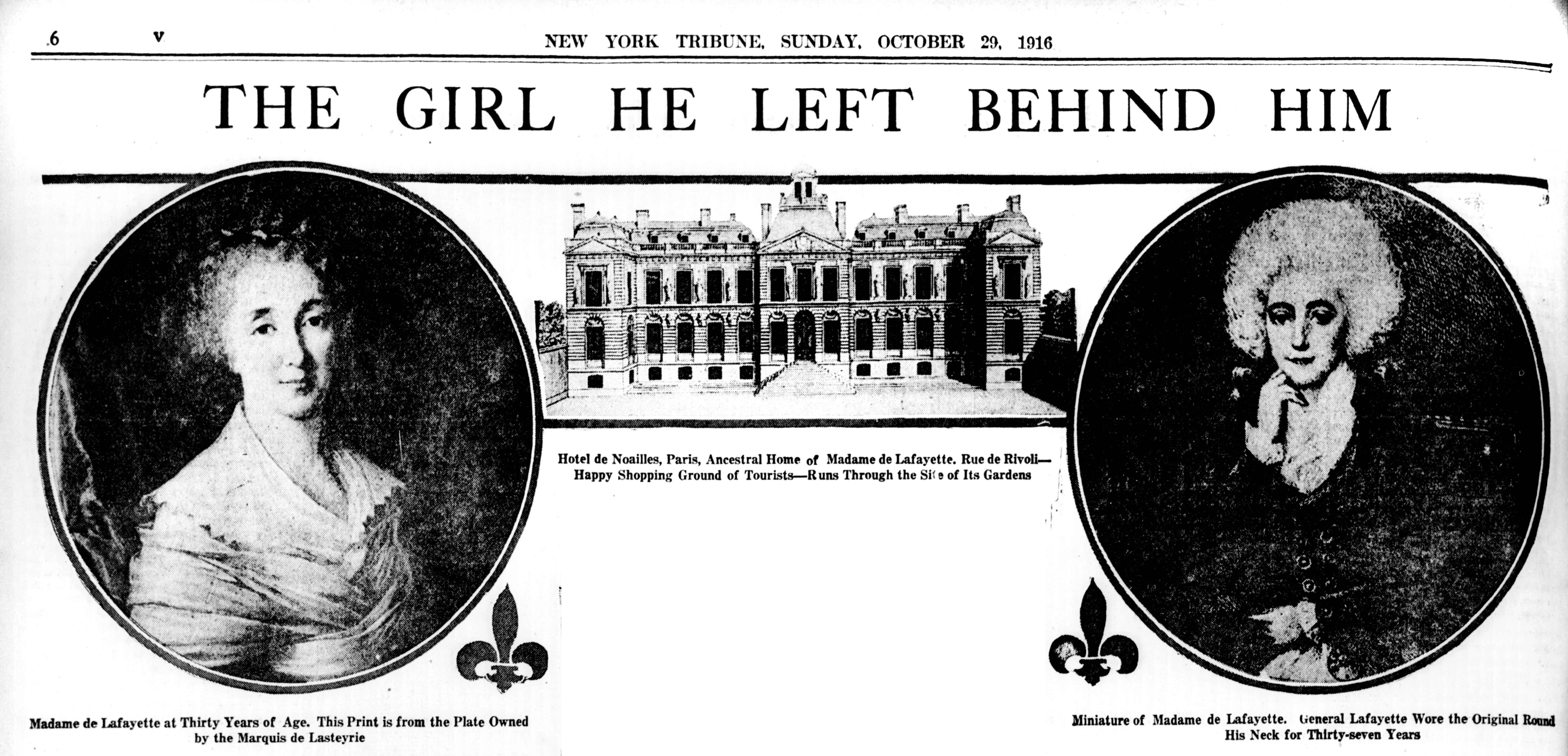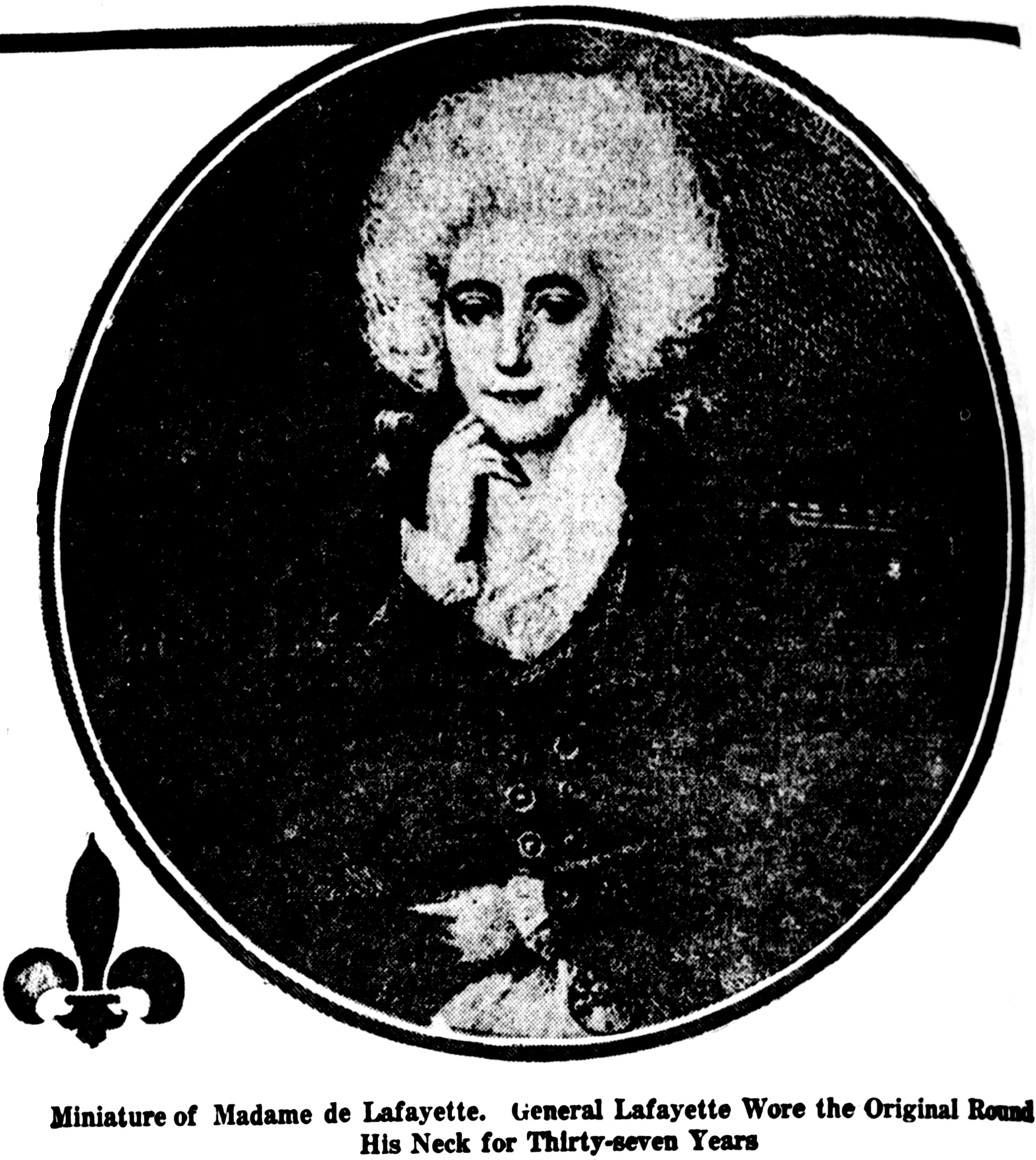The New York Tribune
October 29, 1916, Page 8
The Girl He Left Behind Him

America Pays Increasing Homage to the Memory of General Lafayette,
But Who Knows Aught of Adrienne, His Wife?
By Lida Rose M'Cabe
THE birthday of General de Lafayette as a national holiday is passing to its third observance. What of next Thursday, November 2nd, the 159th natal day of his helpmeet, Adrienne de Noailles, that “loyal uncompromising champion of American liberty,” the woman in whose passing, to quote an eminent French critic, the conqueror of Cornwallis “lost not only his companion but his conscience”?
Who in this day hears of the girl-wife who smothered her tears in laughter when word came that her nineteen-year-old lover-husband had left her to risk life and fortune in a foreign cause, hid her tears lest the anger of her father, the powerful Duke d'Ayen, be intensified against the dashing young soldier Washington was to cherish as “my own son”?
In this day of loud acclaim, when no woman of wealth or social prominence contributes a dollar to a Lafayette Kit, Franco-American ambulance or hospital or dons the picturesque Red Cross garb to succor French wounded without headline in newspaper or magazine, it is well to recall the silent self-sacrifice of America's half forgotten friend, Adrienne de Noailles.
America, like a motif in a Wagnerian opera, ran through Mme. de Lafayette's stormy life. How it played upon her heart strings, how close was her touch, how intelligent her sympathy with the makers of our early annals, are a tale never told, for histories are man written and her portrait is not conspicuous in galleries of women of the French courts.
Good to recall on this 159th birthday how in happy hours she dreamed to visit our shores; in direst moment turned to us with faith and hope. Did the America of her day make good her confidence? Is the America of our day fully alive to its indebtedness to the France now fighting for its very existence?
 Madame de Lafayette at Thirty Years of Age.
Madame de Lafayette at Thirty Years of Age.This Print is from the Plate Owned by the Marquis de Lasterie
It was in the lovely gardens of Hotel de Noailles? — the famous Paris house of her forebears — “for four hundred years the proudest family of France outside of royalty” that Adrienne de Noailles first met the Marquis de Lafayette.
She was nine, he eleven years old, a shy, awkward, red-haired boy. Lafayette came to the gardens on fete days from the Jesuit College of St. Plessis, to which he was sent by the old aunt with whom he lived in the fourteenth century fortress-chateau, Chavaniac-Lafayette, in Auvergne, in the south of France.
The Noailles children had a pony and cart and a straitlaced governess, upon whom Lafayette played pranks. The memory of the garden frolics remained with Adrienne and Gilbert (as she called America's hero) to their final parting, Christmas Eve, 1807.
The first and only rift in the emotional lute of Adrienne's parents, the Duke and Duchess d'Ayen, was the coming of Lafayette's guardian to propose marriage of his ward with Adrienne. Lafayette was at the time fourteen years old, Adrienne twelve. The youthful marquis was an orphan — last of a martial line antedating the Crusades — and independent possessor of half a million of our money.
The gay, witty, money-loving, power-grasping duke was for the marriage. His unworldly duchesse opposed it. The more the duke pleaded, firmer stood the duchesse, until the duke betook himself to Versailles, where he was high in the service of the King. There he pouted in most undukely fashion for more than a year, while the little Noailles girl in the great town house wondered what it was all about.
The wise duchesse, meanwhile, permitted Adrienne and the little red-headed boy, innocent of the breach they had caused, to continue play in the gardens that followed the orangery of the Tuileries to the flowery banks of the Seine. Lafayette already dreamed of romance and adventure, and in Adrienne he had a companion responsive to his wildest fancy.
Before a year's end the duchesse withdrew her objection to the marriage on condition that it be deferred until Lafayette completed his education at the Military Academy of Versailles and that after marriage they live with her at Hotel de Noailles, where also dwelt, after the manner of the time, the duke's sister, the famous Countess de Tessé, who labored twenty years to give France a constitution like that of the United States.
The children were married of an April day in 1774 in regal splendor at Church St. Roche, favorite scene to this hour of marriages and funerals of the old noblesse. Lafayette was sixteen, Adrienne fourteen. Commissioned an officer in the Black Mousquetaires, he was shortly ordered to Metz, where came the turning point of his career. For it was at Metz Lafayette heard of the struggles of the American colonists and resolved to enlist in the American cause.
“Had I received word from you at Bordeaur that you needed me, that you did not approve of my course,” often said Lafayette to Adrienne in after years, “l would never have gone to America.”Had this half-forgotten woman protested, how different might have been America's history!
No cable, no wireless, to tell the deserted girl-wife — she was now eighteen — of the fifty-six-day voyage that landed Lafayette on American soil! No liner to speed his letters to her! It was in the streets of Paris that tidings came to her of the Battle of Brandywine, in which Lafayette was wounded. The year of 1778 passed ln torment. No news! The Virginia campaign, in recognition of which the King made Lafayette Field Marshal of the French Army, cost Mme. de Lafayette, she told her daughter Virginia, “untold anguish.&rdauo;
When Lafayette returned to France after his second voyage to America he found Adrienne in perfect sympathy with his dream of a French republic. Between her and the major general of the American Army developed a sympathy and understanding that ripened into a union as ideally perfect as that of Robert and Elizabeth Browning. Miniature of Madame de Lafayette
Miniature of Madame de LafayetteGeneral Lafayette Wore the Original Round His Neck for Thirty-seven Years
It was the writer's good fortune to spend two days and nights practically mistress of Chavaniac-Lafayette, the fortress-chateau to which General de Lafayette retired for four years upon his return from his last voyage in the interest of American arms. There for four brief years Mme. de Lafayette, with husband and children, had her first release from anxieties born of America's martial troubles.
The chateau, in its pitiable decay, exhales today Lafayette's unfailing devotion to America. It is a veritable patriotic shrine, crowning a rocky promontory framed by the blue veiled mountains of Auvergne. There, on the salon walls, together with ancestral portraits of Crusaders, field marshals and court ladies, I found engravings of Washington, Franklin, Jefferson, Jackson and Lafayette on a Virginia battlefield, his horse held by a Southern negro.
Furled in the chimney corner was the Stars and Stripes. Flanking the banquet room, topping the terraced garden in which George Washington Lafayette hid his father's sword, presented by Congress, is a library of 2,000 books on American wars. In marble bust on either side are Washington and Franklin, confronting a facsimile of the Constitution of the United States with its autographic signatures.
For hours it was given me to browse in the old tower room and its adjoining suite of bandbox boudoirs and the dismantled chapel, where Mme. de Lafayette poured out her agonizing prayers for the liberation of Lafayette imprisoned beyond the Prussian frontier — to-day, as then, France's bete noir! Letter after letter she wrote to Washington imploring him to seek the liberation of Lafayette.
Good it is to recall in these old tower rooms that it was an American woman, Elizabeth Kortright, wife of James Monroe, America's second Minister to France, who literally saved Mme. de Lafayette from the guillotine! Liberated from prison, it was as Mrs. Motier, of Hartford, Conn., that Mme. de Lafayette sailed from France with her two daughters aboard an American ship. At Hombourg she went ashore and made her way to the Austrian court, to plead in vain for the liberation of Lafayette, Before embarking on this perilous journey — French were forbidden on Austrian soil &mdashl she sent her only son, George Washington Lafayette, to General Washington's Mount Vernon home.
“Far away from scenes unworthy of him, I would have him renew the study three years of misfortune has interrupted,&rdauo; she wrote Washington, “and make himself capable of fulfilling the duties of an American Citizen, of which the sentiments and principles will always be those of a French citizen.”
No letter from that worshipped son reached her during her three years of self-imprisonment with Lafayette, in Olmutz, so fearful was the Austrian government that America would learn of the true condition of Lafayette.
It seems incomprehensible to this generation that Lafayette sould have been held — a prisoner — for five years, especially when the highest and mightiest were continuously seeking his liberty — Incomprehensible were it not for today's World War!
Adrienne and Lafayette's longing for America was not to be realized, for with liberation neither had strength nor money for the voyage.
In Picpus Cemetery, which Mme. de Lafayette's personal effort secured for the victims of the Revolution, she rests beside the hero to whom she owed her life's “bitter sweet.”
In 109 years — she died at forty-eight — three standards have been placed on General de Lafayette's tomb — Lafayette Post, Loyal Legion and Sons of the Revolution. But there is no standard on the tomb of Adrienne.
- The Girl He Left Behind Him, The New York Tribune, October 29, 1916, Page 8.